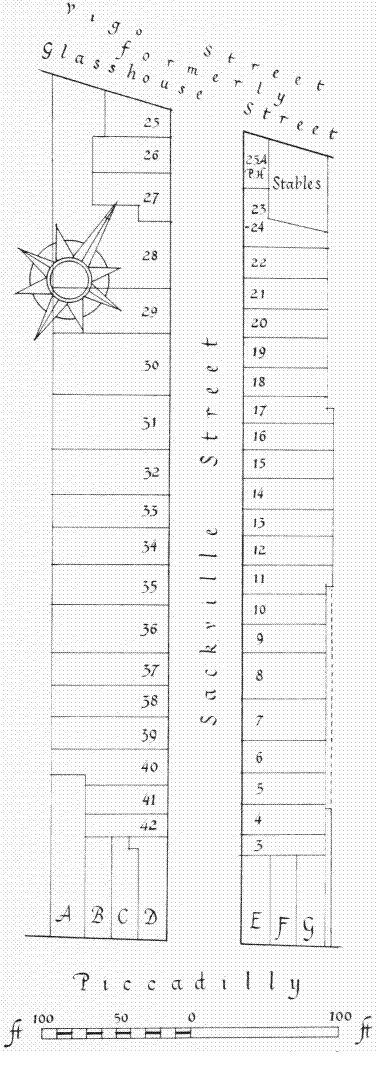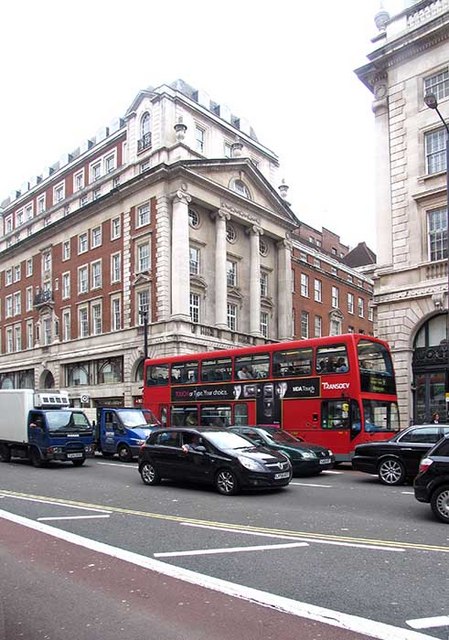Sackville Street, London on:
[Wikipedia]
[Google]
[Amazon]
 Sackville Street is a street in central
Sackville Street is a street in central
 The street runs between Vigo Street in the north and
The street runs between Vigo Street in the north and
 The land on which Sackville Street stands, like Albany and
The land on which Sackville Street stands, like Albany and
''Survey of London'', Volumes 31 and 32: St James Westminster, Part 2 (1963), pp. 342-366. Retrieved 6 June 2014. Sackville Street is first mentioned in the Ratebooks in 1679. By 1730 the former leases on the land that is currently Sackville Street had all expired and William Pulteney, later the Earl of Bath, had the site cleared in order to rebuild the street. The rebuilding laid out the street according to the former leasehold divisions with the houses on the west side corresponding with Richard Bull's former lease, and the roadway and eastern side houses corresponding with the former interests of Edward Bew and Robert Chipp. On 1 May 1730, Pulteney signed an agreement with Thomas Phillips of St. George's, carpenter, and John Mist of St. Anne's paviour. These were likely the principal contractors for the construction of the houses, and by 1733 most of the houses were completed. From the start the street attracted a mixed occupancy and included fine homes and shops. At the time of building it included two apothecaries, a cheesemonger, a tavern and a coffee house. Tailors were also prominent, including 13 listed in the Post Office directory of 1830.
UCLA Department of Epidemiology, 2014. Retrieved 6 June 2014. Snow is considered one of the fathers of modern
 Numbers 29, 30 & 30a, 31, 32, 33, 34 & 35, and 36 are all listed with
Numbers 29, 30 & 30a, 31, 32, 33, 34 & 35, and 36 are all listed with
 Sackville Street is a street in central
Sackville Street is a street in central London
London is the Capital city, capital and List of urban areas in the United Kingdom, largest city of both England and the United Kingdom, with a population of in . London metropolitan area, Its wider metropolitan area is the largest in Wester ...
which today is mainly composed of offices and the rears of retail premises, but once was the home to several important medical figures.
Location
 The street runs between Vigo Street in the north and
The street runs between Vigo Street in the north and Piccadilly
Piccadilly () is a road in the City of Westminster, London, England, to the south of Mayfair, between Hyde Park Corner in the west and Piccadilly Circus in the east. It is part of the A4 road (England), A4 road that connects central London to ...
in the south. It has no other exits.
History
 The land on which Sackville Street stands, like Albany and
The land on which Sackville Street stands, like Albany and Burlington House
Burlington House is a building on Piccadilly in Mayfair, London. It was originally a private English Baroque and then Neo-Palladian mansion owned by the Earl of Burlington, Earls of Burlington. It was significantly expanded in the mid-19th cent ...
, was formerly known as Stone Conduit Close. It was bounded on one side by Penniless Bank and on the other by Swallow Close. It passed into Crown ownership in 1536 and formerly belonged to the Abbot and Convent of Abingdon. The land was then much divided, leases granted and ended, and ownership changed several times."Sackville Street"''Survey of London'', Volumes 31 and 32: St James Westminster, Part 2 (1963), pp. 342-366. Retrieved 6 June 2014. Sackville Street is first mentioned in the Ratebooks in 1679. By 1730 the former leases on the land that is currently Sackville Street had all expired and William Pulteney, later the Earl of Bath, had the site cleared in order to rebuild the street. The rebuilding laid out the street according to the former leasehold divisions with the houses on the west side corresponding with Richard Bull's former lease, and the roadway and eastern side houses corresponding with the former interests of Edward Bew and Robert Chipp. On 1 May 1730, Pulteney signed an agreement with Thomas Phillips of St. George's, carpenter, and John Mist of St. Anne's paviour. These were likely the principal contractors for the construction of the houses, and by 1733 most of the houses were completed. From the start the street attracted a mixed occupancy and included fine homes and shops. At the time of building it included two apothecaries, a cheesemonger, a tavern and a coffee house. Tailors were also prominent, including 13 listed in the Post Office directory of 1830.
Former residents
Willem van de Velde the Elder, the Dutch seascape painter, was living in Sackville Street at the time of his death in 1693. In the late eighteenth and early nineteenth centuries Thomas Gray and William Constable operated as jewellers and goldsmiths in the street. In Jane Austen's ''Sense and Sensibility
''Sense and Sensibility'' ( working title; ''Elinor and Marianne'') is the first novel by the English author Jane Austen, published in 1811. It was published anonymously: ''By A Lady'' appears on the title page where the author's name might h ...
'' (published 1811), Marianne and Elinor Dashwood visit "Gray's", a jeweller in the street and one of only two real world shops mentioned in the Austen novels."Consumer goods" by David Selwyn in
28 Sackville Street was the home of the Sackville Gallery between the two World Wars where the important exhibition of Futurist painting was held in 1912.
30 Sackville Street was the home of Sir Everard Home (1746–1832), Serjeant-Surgeon to the King, and Baronet 1813.
John Snow
John Snow (15 March 1813 – 16 June 1858) was an English physician and a leader in the development of anaesthesia and medical hygiene. He is considered one of the founders of modern epidemiology and early germ theory, in part because of hi ...
, the pioneer of anaesthesia
Anesthesia (American English) or anaesthesia (British English) is a state of controlled, temporary loss of sensation or awareness that is induced for medical or veterinary purposes. It may include some or all of analgesia (relief from or prev ...
, lived at number 18 from 1852 to his death in 1858.''JOHN SNOW'S HOMES''.UCLA Department of Epidemiology, 2014. Retrieved 6 June 2014. Snow is considered one of the fathers of modern
epidemiology
Epidemiology is the study and analysis of the distribution (who, when, and where), patterns and Risk factor (epidemiology), determinants of health and disease conditions in a defined population, and application of this knowledge to prevent dise ...
, in part because of his work in tracing the source of a cholera outbreak in Soho, London, in 1854.
James Yearsley (1805–1869), aural surgeon, once had a clinic at 32 Sackville Street. A green plaque
A blue plaque is a permanent sign installed in a public place in the United Kingdom, and certain other countries and territories, to commemorate a link between that location and a famous person, event, or former building on the site, serving a ...
was unveiled on 27 May 1994 which reads "Westminster City Council Dr. James Yearsley, MD, MRCS, LRCP, 1805 - 1869, founded the Metropolitan Ear Institute here in 1838. Mr. Ronnie Yearsley."
Listed buildings
 Numbers 29, 30 & 30a, 31, 32, 33, 34 & 35, and 36 are all listed with
Numbers 29, 30 & 30a, 31, 32, 33, 34 & 35, and 36 are all listed with English Heritage
English Heritage (officially the English Heritage Trust) is a charity that manages over 400 historic monuments, buildings and places. These include prehistoric sites, a battlefield, medieval castles, Roman forts, historic industrial sites, Lis ...
.
References
{{coord, 51.5095, -0.1383, type:landmark_region:GB, display=title Mayfair Streets in the City of Westminster Burlington Estate